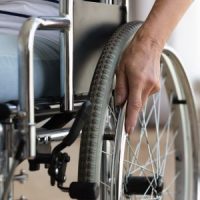How Paralysis Happens

Paralysis is the most serious kind of back injury we can imagine having. Understanding how paralysis happens, involves understanding the anatomy of your spine.
The Anatomy of the Spine
Your delicate spinal nerves are protected by and encased by, bony structures called vertebrae. Between those bones are jelly-like discs, which allow your back to move freely.
These are all protective structures for the spine. But ironically, they can also be the source of grievous injury, because of their close proximity to the spine, which runs through these structures.
For example, in an accident, we can often have a slipped, or ruptured disc. These kinds of injuries are serious enough, but they are made more serious when the disc ruptures and then protrudes into the spinal column, into the spinal nerves.
Not Just Paralysis
Remember that spinal damage isn’t just limited to paralysis. Imagine a disc or a vertebrae rupturing to the point it is pushing up against spinal nerves, but not severing the nerves. When this happens, the victim can have chronic, ongoing pain or numbness in a limb, even though there isn’t any immediate risk of paralysis.
When Paralysis Happens
When the structures of the spine are so out of place, or rupture so significantly, that they cut off, or sever nerves in the spine, is when paralysis happens. But because the spine’s structures are so close to the spinal column, it doesn’t take as serious of an impact as you may think, for the structures to be moved so much that they threaten paralysis.
In fact, sometimes you may simply have a ruptured or herniated disc, that doesn’t threaten paralysis, but doctors will still need to perform surgery, because the spine is dangerously close to spinal nerves—so close that paralysis could happen in the future with even an everyday impact.
Types of Paralysis
Paralysis can be complete or incomplete. In incomplete paralysis is where a body part has a loss of function but not a total loss. Compare this to complete paralysis, where the areas below the location of where the spine was severed, are completely unable to move or have any feeling.
Symptoms
You may think that you would know immediately whether your spine has been severed, but in many cases, you don’t. In some cases, the symptoms of paralysis can mimic those of a ruptured disc.
Loss of feeling, temperature changes on the body at the site of the accident and in the limbs, loss of bladder control, weakness of any limbs, or even problems breathing, can all be signs that your spinal cord is being significantly impacted by a disc or vertebrae.
Getting treatment for a spinal cord injury is vital; studies have shown that in some cases, the level and extent of a victim’s recovery depends on how quickly treatment is received, and how early rigorous physical therapy is given. In fact, some forms of paralysis can heal, in part if not fully. That means that quick medical action is vital to having as full a recovery as is possible.
If you have suffered a back injury or paralysis because of the careless actions of someone else, we can help. Call the Clinton personal injury lawyers at Fox Willis Burnette, PLLC, today.
Sources:
medlineplus.gov/paralysis.html#:~:text=Paralysis%20is%20the%20loss%20of,or%20it%20can%20be%20widespread
my.clevelandclinic.org/health/diseases/15345-paralysis
